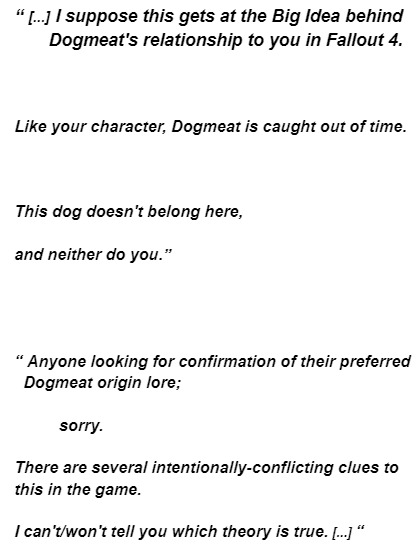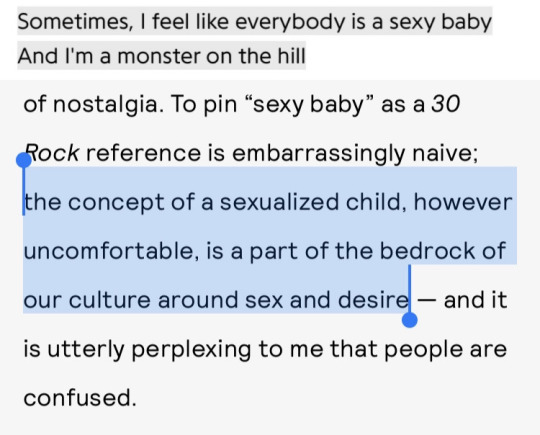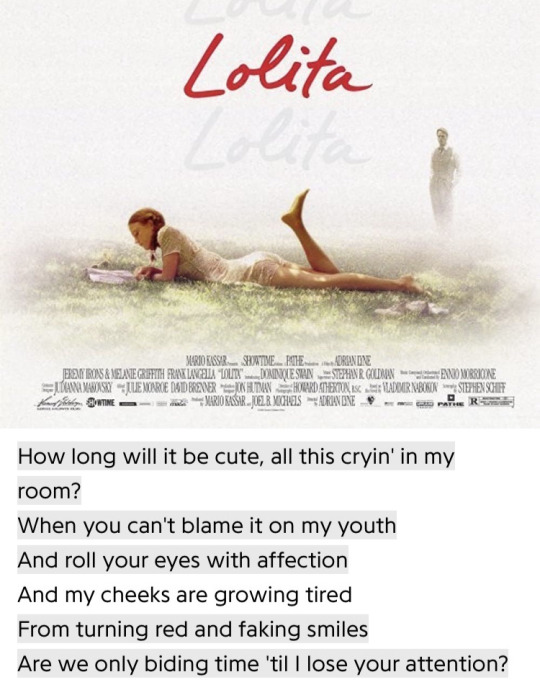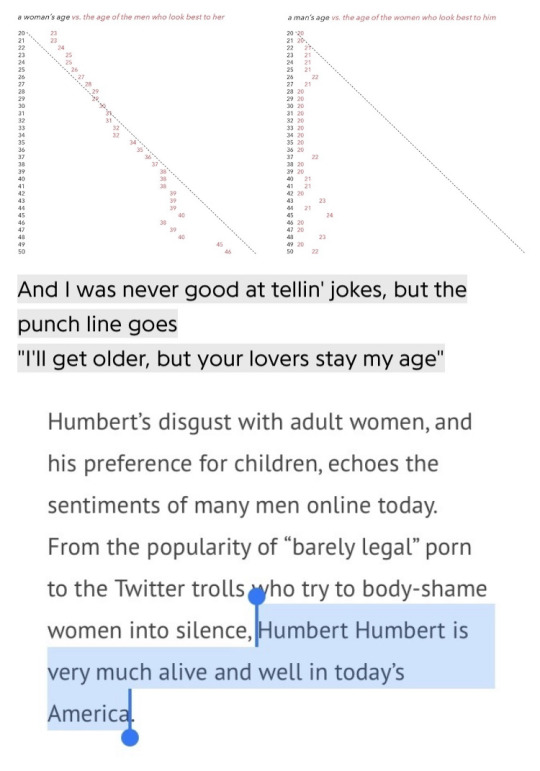#June 13 2021
Photo

megpatrickmusic: Raise your hand if you’ll be front row at 3pm... LFG @countrythunder.iowa 🤘🏼
📸: @billwoodcock
3 notes
·
View notes
Text

WHERE: Social Media
WHEN: June 13, 2021
Free People Share Good Vibes Floral Shirt - Sold Out
0 notes
Text





My very last comic for The Nib! End of an era! Transcription below the cut. instagram / patreon / portfolio / etsy / my book / redbubble
The first event I went to with GENDER QUEER was in NYC in 2019 at the Javits Center.
So many of the people who came to my signing were librarians, and so many of them said the same thing: "I know exactly who I want to give this to!"
Maia: "Thank you for helping readers find my book!"
While working on the book, I was genuinely unsure if anyone outside of my family and close friends would read it. But the early support of librarians and two American Library Association awards helped sell two print runs in first year.
Since then, GENDER QUEER been published in 8 languages, with more on the way: Spanish, Czech, Polish, French, Italian, Norwegian, Portugese and Dutch.
It has also been the most banned book in the United States for the past two years.
The American Library Association has tracked an astronomical increase in book challenges over the past few years. Most of these challenges are to books with diverse characters and LGBTQ themes. These challenges are coming unevenly across the US, in a pattern that mirrors the legislative attacks on LGBTQ people.
The Brooklyn Public Library offered free eCards to anyone in the US aged 13-21, in an effort to make banned books more available to young readers. A teacher in Norman, Oklahoma gave her students the QR code for the free eCard and lost her job. Summer Boismeir is now working for the Brooklyn Public Library.
Hoopla and Libby/Overdrive, apps used to access digital library books, are now banned in Mississippi to anyone under 18. Some libraries won’t allow anyone under 18 to get any kind of library card without parental permission.
When librarians in Jamestown, Michigan refused to remove GENDER QUEER and several other books, the citizens of the town voted down the library’s funding in the fall 2022 election. Without funding, the library is due to close in mid-2024.
My first event since covid hit was the American Library Association conference in June 2022 in Washington, DC. Once again, the librarians in my signing line all had similar stories for me: “Your book was challenged in our district"
"It was returned to the shelf!"
"It was removed from the shelf..."
"It was moved to the adult section."
Over and over I said: "Thank you. Thank you for working so hard to keep my book in your library. I’m sorry you had to defend it, but thank you for trying, even if it didn't work."
We are at a crossroads of freedom of speech and censorship. The future of libraries, both publicly funded and in schools, are at stake. This is massively impacting the daily lives of librarians, teachers, students, booksellers, and authors around the country. In May 2023, I read an article from the Washington Post analyzing nearly 1000 of the book challenges from the 2021-2022 school year. I was literally on route to a festival to talk about book bans when I read a startling statistic.
60% of the 1000 book challenges were submitted by just 11 people. One man alone was responsible for 92 challenges. These 11 people seem to have made submitting copy-cat book challenges their full-time hobby and their opinions are having an outsized ripple effect across the nation.
WE NEED TO MAKE THE VOICES SUPPORTING DIVERSE BOOKS AND OPPOSING BOOK BANS EVEN LOUDER.
If you are able too, show up for your library and school board meetings when book challenges are debated. Send supportive comments and emails about the Pride book display and Drag Queen story hours. If you see a display you like– for Banned Book Week, AAPI Month, Black History Month, Disability Awareness Month, Jewish holidays, Trans Day of Remembrance– compliment a librarian! Make sure they feel the love stronger than the hate <3
Maia Kobabe, 2023
The Nib
19K notes
·
View notes
Text

In every mainline Fallout game except for New Vegas, players can earn the loyalty of a dog known as “Dogmeat.” As part of the main quest of Fallout 4, Dogmeat assists in tracking down the antagonist, even if the player has never encountered him before. When you leave Kellogg’s home, Nick simply starts talking about Dogmeat as if he’s a known quantity.
Perhaps related to this quirk of the world, Dogmeat is first named in this game when the clairvoyant Mama Murphy recognizes him and addresses him by name. The game’s UI calls him “DOG” until he is recognized by Valentine or Murphy. It seems clear that this german shepherd is somehow an independent agent with a good reputation, or something.
Dogmeat does not have a loyalty quest associated with him, which is how the player would earn the other companions’ perks. However, upon finding Astoundingly Awesome Tales #9 within the Institute, Dogmeat becomes more resistant to damage. While this isn’t coherent or conclusive evidence of Dogmeat being a synth, it’s plainly prompting the audience to consider that idea. In light of these factors, his origins have been fiercely debated among the community.
The skeptics and “hard sci-fi” fans out there would have you believe that he’s merely a famous stray dog who solves crimes. But I believe there's something more remarkable at work.
There's a section in the Fallout 2 instruction book called the Vault Dweller's Memoirs, where the player character of the first game recounts what canonically happened. Due to Fallout’s famously terrible companion AI, if you travelled to Mariposa with Dogmeat, he would consistently run into the force fields and get vaporized. So, in the Memoirs, we learn that this is exactly what became of Dogmeat Prime, in canon. He loyally sprinted into a wall of solid light, and disappeared. What if our buddy simply awoke in a new, confusing place?
In Fallout 2, Dogmeat must be found at the Cafe of Broken Dreams, which is explicitly a liminal space. It appears randomly to travellers in the desert. The NPCs within are frozen in time, such as a young version of President Tandi, who mentions that Ian went to “the Abbey,” an area cut from the game. To gain Dogmeat’s trust, the Chosen One must equip the Vault Dweller’s V-13 jumpsuit, which Dogmeat recognizes as belonging to his dead master. You can also attack him to spawn Mad Max, who claims ownership of the dog. Max fits the description of Dogmeat's original owner given in Fallout.
There’s also the “puppies” perk in Fallout 3, which enables you to restore Dogmeat, in the event of his death. “Dogmeat’s puppy” inherits his base and ref ids. In other words, they ARE the same NPC, just renamed. So, the way this actually articulates is that whenever Dogmeat dies in combat, you can find him waiting for you back at Vault 101. In practice, it’s almost Bombadilian.
Lastly, please consider the following developer context.

In June of 2021, the dog who performed Dogmeat’s motion capture and voice for Fallout 4 passed away. A statue of her was placed outside of every Vault in the China-exclusive sequel to Fallout Shelter. She still watches over each player.
River's owner, developer Joel Burgess, honored her in a brief thread about her involvement in the game, and shared much about his thought process and design goals while leading the character’s development. The Dogmeat project changed course early on, after Mr. Joel saw a new member of the art team gathering references of snarling German Shepherds. This motivated him to bring River into the studio, so the artists and developers could spend time with her.
He wanted to steer the team away from viewing Dogmeat as a weapon, and towards viewing him as a friend. Everything special about Dogmeat was inspired by River. For example, whenever you travel with Dogmeat, he’s constantly running ahead of you to scout for danger, then turning to wait for you. This was inspired by River’s consistent behavior on long walks.
The only way they were able to motivate River to bark for recordings was by separating her from Joel while he waited in the next room.
Reading the thread, it’s very clear that he hoped Dogmeat would make players feel safe, encouraging them to explore, and to wonder. In his closing thoughts, he said the following:


-Joel Burgess
Mr. Joel felt it was important to express that the ambiguity of Dogmeat’s origin in Fallout 4 was deliberately built into his presentation. He also felt it was important that you know Dogmeat loves you. Dogmeat was designed, on every level, to reflect the audience’s inspirations, and to empower their curiosity.
The true lore of Dogmeat is a rorschach test. The only “right” answer is to pursue whatever captures your imagination.

770 notes
·
View notes
Text
As someone who is active on all platforms from Twitter to Tumblr and tiktok, I've concluded that it's bad everywhere and were all cringe and that's okay
#no but legit ive met abuncha friends on all 3 platforms#im not active on instagram lol#theres ups and downs in everything#and hot take tumblr isnt the best#i dont ussualy post opinions on tumblr#this is mostly abt the mcyt fandom but its similar with other fandoms i think#this is staying in the drafts#draft: 13 june 9.50 am 2021#edit: 13 july 2022#i still stand by this
0 notes
Text










1. anti-hero, taylor swift / 2, 19. “taylor swift’s ‘sexy baby’ lyric is more than a ‘30 rock’ reference,” sophia june for nylon magazine / 3, 4, 12, 22. taylor swift ages 14-16, photographed by andrew orth / 5, 23. dominique swain age 15, photographed for lolita (1997) / 6, 17. “the fetishization of girlhood,” m.c. easton / 7. lolita (1962), dir. stanley kubrick / 8. 22 (mv), taylor swift / 9. anti-hero (mv), taylor swift / 10, 14, 18. nothing new, taylor swift ft. phoebe bridgers / 11. “2008’s country lolita: taylor swift,” gavin edwards for rolling stone / 13, 21. lolita (1997), dir. adrian lyne / 15. okcupid dating chart: age preferences by gender / 16. all too well (ten minute version), taylor swift / 20. university of pittsburgh 2021-2022 undergraduate catalog / 23. would’ve, could’ve, should’ve, taylor swift
apologies for this ridiculously long megathread, but i found a ton of these photographs of taylor from when before she was famous, around ages 14-16, and ooh boy, did they get me thinking…
sometimes i wonder if she just really lucked out with the mostly desexualized “innocent girl-next-door” persona becoming her brand throughout her early career, because it looks like things could have gone in a very different direction for her in another universe.
like you can literally see taylor being de-aged between her debut and fearless era as her public image cemented…the posing, the makeup, the hair, the clothing…it’s all very deliberate and sinister.
and now, all these years later, no one knows better than taylor herself that the most desirable thing a woman can be is not a woman, but a girl…a sexy baby, if you must.
her heart-shaped sunglasses, nothing new, the ten minute version of all too well, would’ve could’ve should’ve…she knows all about society’s sickness, its simultaneous fetishization and destruction of girlhood. she knows because she’s lived through it.
we don’t often categorize her or think of her as one, but she was a child star, and she barely escaped its curse. just barely. but unlike so many other child stars, unlike dolores haze, she survived with her voice and her pen, and she can see it all now, it was wrong.
#web weaving#parallels#connections#thread#taylor swift#midnights#midnights ts#dolores haze#swifties#girl blogger#girl blog#girlblogging#girlhood#lyrics#lyric analysis#nothing new#phoebe bridgers#dominique swaine#anti-hero#would’ve could’ve should’ve#all too well#all too well ten minute version#thoughts#feminism#feminist
6K notes
·
View notes
Text

The sexual assault of sleeping women: the hidden, horrifying rape crisis in our bedrooms (Anna Moore, The Guardian, June 15 2021)
"Naming specific acts, rather than using broad – and loaded – terms such as “abuse” or “rape”, her survey asked more than 22,000 women if, for example, they had ever been spat at, or strangled, kicked or bitten.
It also asked respondents if they had ever woken to their male partner having sex with them or performing sex acts on them while they slept.
To this question, 51% answered yes.
This was not randomised sampling – the survey was widely shared online and participants were self-selected. For this reason, it’s hard to extrapolate from the findings.
The results sparked a predictably polarised online response. “This was extremely validating for me after years of thinking, ‘Am I being raped?’ I’m not alone”, tweeted one woman.
“It’s why I now jerk awake if someone even gently brushes against me while I’m sleeping, 13 years later,” wrote another.
Other comments included, “Only chance I get!” and “the other half was OK with it!”
Katie Russell, spokesperson for Rape Crisis, says she was “not massively surprised” by the findings.
“There isn’t a lot of research into the multiple ways women experience violence from known men, but we do know the numbers are so much higher than any official statistics,” she says.
“Rape myths are still incredibly pervasive. It’s commonly believed that if it’s your boyfriend or your spouse, if you’re sharing a bed, if you’re naked, if you consented earlier, then it can’t be rape.
There is a really big difference between gently waking your partner and initiating sexual activity and actually doing something sexual or penetrating someone while they’re still asleep. (…)
In Martha’s case, the rape happened once, but for some men, seeking sex with a sleeping woman is an active preference, a fetish known as somnophilia.
Svein Overland, a Norwegian psychologist, is one of the few to have studied it – his interest sparked partly by his work in prisons, trying to understand the motivations of sex offenders, and also by his work with victims of what Norwegians call “after-party rapes” – attacks on vulnerable women who were either sleeping or drugged.
Overland believes somnophilia is part of the wider growth of what he calls “one-way sex”.
His research into online porn showed a steep rise over the past decade in categories such as “sleeping sex”, as well as other forms of sex that are based on unresponsiveness, on only meeting your own needs.
(“Flexi dolls” is another example – where women pretend to be sex dolls.)
These preferences overlap with porn itself, says Overland. “With one-way sex, with porn, with masturbation, there’s no dance, no seduction, no interaction and no pressure to perform,” he says.
“The more I looked at this area, the more you see that a lot of men are afraid of having sex.
Society is becoming more pornified but, at the same time, many studies show that people are becoming less sexually active. We have young men buying Viagra, unable to keep an erection.”
A sleeping woman is no threat – she’s absent, an object, a receptacle. (…)
“There seems to be a perception that something like this is a ‘lesser crime’ because it might not be at the hands of a stranger but your partner.
But what would feel worse? Being pickpocketed by a stranger or robbed by someone you love and trust?” she asks.
“The idea that you’re asleep so it didn’t require violence is also very dangerous. Penetrating someone’s body without their permission is an inherently violent act.
“Imagine being asleep and waking to find someone going through your personal things,” she continues. “Now imagine it’s your actual body that has been intruded into.” (…)
“When I first left him, I wouldn’t sleep. I’d lie awake all night and have hallucinations – him raping me.
Those flashbacks, that trauma response, was the mind and body trying to piece things together.
Even now, nine years on, I still wake at two every morning. I don’t even need to check the clock.
We know that the body stores memories of trauma – and I think 2am is when it used to happen.” (…)
In February 2020, she told the jury: “There has never been a part of me that has not been profoundly impacted,” and that in the immediate aftermath, she suffered PTSD and had tried to take her own life.
She said she had felt “unsafe everywhere”, frightened to trust anyone, even her parents."
432 notes
·
View notes
Photo

A Year of Sunrises : Does the Sun always rise in the same direction? No. As the months change, the direction toward the rising Sun changes, too. The featured image shows the direction of sunrise every month during 2021 as seen from the city of Edmonton, Alberta, Canada. The camera in the image is always facing due east, with north toward the left and south toward the right. As shown in an accompanying video, the top image was taken in 2020 December, while the bottom image was captured in 2021 December, making 13 images in total. Although the Sun always rises in the east in general, it rises furthest to the south of east on the December solstice, and furthest north of east on the June solstice. In many countries, the December Solstice is considered an official change in season: for example the first day of winter in the North. Solar heating and stored energy in the Earth's surface and atmosphere are near their lowest during winter, making the winter season the coldest of the year. via NASA
4K notes
·
View notes
Text
I gave too much thought to this, I don't know why I care so much about this

So when I was making memes based on the @i-cant-sing Resident Evil 8 series and some of my dumb Head cannons. For one meme I had to do some math. Y/n was at least 12-13 years old during the events of RE7 so she can be at least 15-16 years old in RE8.
So Ethan was born 1984 so let's give a random day and month so February 20th, 1984, and Mia was given a full date of birth December 14, 1984. Ethan was like 27 years old and Mia was 26 years old when they were married on May 29th, 2011.
If Y/n was made on their honeymoon let's say May 31, 2011, and she would be born on February 21st, 2012. RE7 takes place in 2017 give it a random day so June 8th. That would make Y/n 5 years old and RE8 takes place on February 9, 2021, which would make Y/n 8 years old. Which wouldn't make sense so I have to redo the math.
So Mia was 19 years old in 2004 which would make Ethan 20 years old. Let's say Mia was 19 years old when she had Y/n. The average cycle of Months of pregnancy is 8-9 months but for this let's say 8 months. Y/n was born on November 2004 the day I gave was the 12th.
During RE7 2017 y/n was 12 years old and RE8 would make Y/n 16 years old. Fun fact the Re8DLC takes place in the year 2037 making Y/n 32 years old.
#yandere resident evil#yandere ethan winters#yandere resident evil8#yandere platonic#platonic yandere#yandere mia winters#I did all this math but couldn't be bothered to do so when I was in school#thanks for reading all of this#platonic yandere resident evil
89 notes
·
View notes
Note
Can you do a Tobi Instagram imagine where they haven't posted in a while and then they post that in the time span that they had a baby or got married
SURPRISE? | TBJZL
✿ : ⋆₊˚➶ .♡

tags: fluff, tobi x reader
warnings: some cursing
a/n: loved this idea so much!! finally found the time to do it
-
y/un ✔

y/un: my cuties!!
2 June 2021
comments •
sidewaysmen: miss her so much she and tobi never post anymore
9 January 2023
wlvrsso: haven’t seen her in years even in the sidemen channel…
wroetohaw: wonder if she and tobi broke up
10 January 2023
tobjizzle ✔

tobjizzle: unforgettable trip love you so much @y/un
3 December 2021
comments •
callitway: bro has not posted since 2021
16 July 2023
luxopsh: my g please come back
harrysgf: bros gone for good go watch him on sidemen
13 July 2023
-
7 September 2023

replies • dms
whatyoulooknfor: HELLO WHAT IS THIS REVIVAL
pulluspb: OMG WE MISSED YOU Y/N
y/nswife: WELCOME BACK WE MISSED YOU
pushitsdoe: GAME NIGHT SO CUTE
cloassw: CUTIES
tombilw: HELLO??? HOW HAVE YOU BEEN?
okdokeyo: OKAY WRLCOME BACK??
sidewaysman: so cute my favourite couples (and simon)
tataswan: wheres talia?
simonmin: NO WAY YOU UPDATED RIGHT AS I WAS GOIBG TO BED
rusoag: ITS NOT A POST BUT WELL TAKE ANY CRUMBS OF Y/N AND TOBI WE CAN GET
-
8 September 2023

replies • dms
runawaybaby: AFTER TWO YEARS OF SILENCE
wroetojaw: FAVOURITE SIDEMEN GFS
wanttodks: CUTIES
todbbn: LOVE YOU GUYS
alfeaod: Y/NS BREAKING HER SILENCE
oweittoyou: POST SOON PLEASE WE LOVE YOY
y/nswife: HOPE YOURE HAVING FUN WE MISSED YOU
sidemenfan: when are you going to be in the sidemen videos again
chloelowe: LIFE UPDATE PLEASE
-
10 September 2023

replies • dms
loveisj: why aren’t you at the stadium?
tobiminter: SO CUTE
minsioon: KAI IS SO FUNNY
tahshanay: TWINING
manifimgo: I SAW YOUR DONATION ON THE SCREEN!!!
ausoustis: LOVE YOU
runawaybaby: WE LOVE A SUPPORTIVE GF
rusoag: I HOPE THEY WIN
luxopsh: WOOOOO
-
10 September 2023

replies • dms
widyes: MY GIRLSS!!!
caislkso: CUTIES
whatsgoosd: WE LOVE THE SUPPORT
plonodj: WE WIN THESEEEE
stepaven: LOVE YOUR FRIENDSHIP
ohjsn: DID YOU SEE TOBIS GOAL OMG
-
miniminter ✔

miniminter: one shot
10 September 2023
comments •
whitahs: HELLO THE LAST PIC????
sidemanup: CHARITY MATCH W
y/nsgf: NO WAY BRO THE LAST PICTURE IS THAT TOBI??
- post is unavailable, user may have deleted or archived it -
y/un ✔

y/un: um surprise!!
10 September 2023
tobjizzle ✔: guess the cats out of the bag
#tobi x reader#tobjizzle#tbjzl#tbjzl imagine#sidemen x reader#sidemen fanfic#sidmen#sidemen imagine#tobi brown#tbjzl x reader
308 notes
·
View notes
Text
An updated (April 3, 2024 7:48am pst) list of WW2 movies and TV shows in chronological order
thought out WW2
-(Imitation Game 2014)
-(The Book Thief 2013)
-(The Zookeeper’s Wife 2017)
-(The Pianist 2002)
1937
October 26, 1937 Defence of Sihang Warehouse (The Eight Hundred 2020)
December 13, 1937 Nanjing Massacre
- (John Rabe 2009)
- (The Flowers of War 2011)
1938
Fall of 1938 (Munich – The Edge of War 2022)
1939
Summer 1939 (Six Minutes to Midnight 2020)
September 3, 1939 King George VI first wartime speech (King’s Speech 2010)
September 17, 1939, Soviet Union Invitation of Poland (The Way Back 2010)
November 30, 1939 Soviet Union invades Finland (The Winter War 1989)
1940
April 9, 1940 Operation Weserübung
-(April 9th [movie] 2015)
-(King’s Choice 2016)
-(Narvik 2022)
-(War Sailors 2023)
April 27, 1940 (Into the White 2011)
June 4, 1940
-Churchill gives “We Shall Fight on the Beaches” speech (Darkest Hour 2017)
-Dunkirk Evaluation (Dunkirk 2017)
July 10-October 31, 1940 Battle of Britain (Battle of Britain 1969)
1941
May 1941 (Call to Spy 2019)
June 22, 1941 Operation Barbarossa
-(Fortress of War [The Brest Fortres 2010)
-(Defiance 2008)
September 8, 1941, Siege of Leningrad begins.
-(Battle of Leningrad [Saving Leningrad] 2019)
-(Leningrad 2009)
October 1941 Battle of Moscow (The Last Frontier [The Final Stand] 2020)
October 1941 Battle of Sevastopol (Battle for Sevastopol 2015)
December 7, 1941, the Empire of Japan attacks Pearl Harbor (Tora! Tora! Tora! 1970)
December 8, 1941 Japan invades Shanghai International Settlement (Empire of the Sun 1987)
1942
January 20, 1942, Wannsee Conference (Conspiracy 2001)
February 1942 Battle of the Atlantic (Greyhound 2020)
February 1942 (The Railway Man 2013)
February 19, 1942, Bombing of Darwin (Australia 2008)
Spring 1942 (U-571 2000)
April 18, 1942 The Doolittle Raid (In Harm’s Way 2018)
June 4, 1942 Battle of Midway (Midway 2019)
1942 Summer Occupation of Jersey Island (Another Mother’s Son 2017 Prime)
July, 10 1942 Easy Company Trains in Camp Tocca (Band of Brothers 01x10 Currahee 2001)
July 21, 1942, Kokoda Track Campaign (Kokoda: 39th Battalion 2006)
August 7, 1942, 1st Marine Division land on Guadalcanal (The Pacific Ep. 1 Guadalcanal/Leckie 2010)
August 19, 1942, Dieppe Raid (Dieppe 1993)
August 23, 1942 Battle of Stalingrad begins (Stalingrad 1993)
September 1942 Formation of Troop 30 (Age of Heroes 2011)
September 18, 1942, 7th Marines Land on Guadalcanal (The Pacific Ep. 2 Basilone 2010)
Autumn of 1942 Battle of the Atlantic (Das Boot 1981)
October 18, 1942, Operation Grouse (Heavy Water War Ep. 2 2015)
November 8, 1942, Operation Torch (The Big Red One 1980)
November 10-17 1942 Vasily Zaytsev kills 225 German Soldiers during the Battle of Stalingrad (Enemy at the Gates 2001)
December 1942 The 1st Marine Division on Guadalcanal is relieved (The Pacific Ep. 3 Melbourne 2010)
December 15, 1942, Battle of Mount Austen (Thin Red Line 1998)
1943
March 13-14 1943, liquidation of the Kraków Ghetto -(Schindler’s List 1993)
April 17, 1943 Operation Mincemeat (Operation Mincemeat 2021)
April 19, 1943, beginning of the Warsaw Uprising (Uprising 2001)
May 4, 1943, Final Mission of The Memphis Bell (Memphis Bell 1990)
May 15, 1943, Salamo Arouch and his family arrive in Auschwitz Concentration Camp (Triumph of the Spirit 1989)
May 27, 1943 Louis Zamperini plane crashes on a search and rescue mission (Unbroken 2014)
May 30, 1943 first All-American Girls Professional Baseball League game played (A League of Their Own 1992)
June 25, 1943, 100th Bomb Group flew its first 8th Air Force combat mission (Master of the Air: Part One 2024)
July 1943
-(The Tuskegee Airmen 1995)
-(The Liberator Ep. 1 2020)
-(Heavy Water War Ep. 5 2015)
July 16, 1943, The 100th Bomb Group bombed U-Boats in Tronbhdim (Masters of the Air: Part Two 2024)
August 17, 1943 the 4th Bomb Wing of the 100th Bomb Group bombed Regenberg (Masters of the Air: Part Three 2024)
September 16, 1943, William Quinn and Charles Bailey leave Belgium (Masters of the Air: Part Four 2024)
September 18, 1943 John ‘Bucky’ Egan returns from leave to join the mission to bomb Munster (Master of the Air: Part Five 2024
October 14, 1943, John ‘Bucky’ Egan interrogated at Dulag Lut, Frankfurt Germany (Masters of the Air: Part Six 2024)
December 26, 1943, 1st Marine Division lands on Cape Gloucester (The Pacific Ep. 4 Gloucester/Pavuvu/Banika 2010)
1944
January 22, 1944, Battle of Anzio
-(The Liberator Ep. 2 2020)
-(Red Tails 2012)
-(Anzio 1968)
February 20, 1944, Hydro Ferry bombing (Heavy Water War Ep. 6 2015)
March 7, 1944, Stalag Luft III Sagan, Germany, Germans find the concealed radio Bucky was using to learn news of the War (Master of the Air: Part Seven 2024)
March 24/25, 1944 Allied Mass Escape of Stalag Luft III (The Great Escape 1963)
June 1944 (Cross of Iron 1977)
June 6, 1944, 00:48 & 01:40 First airborne troops begin to land on Normandy (Band of Brothers 02x10 Day of Days 2001)
June 6, 1944, 06:30 D-Day landings
-(Storming Juno 2010)
-(Saving Private Ryan 1998)
June 10, 1944, Easy Company Takes Carentan (Band of Brothers 03x10 Carentan 2001)
June 15-July 9, 1944 Battle of Saipan
-(Windtalkers 2002)
-(Oba: The Last Samurai 2011)
July, 1944 The Monuments Men land in Normandy (The Monuments Men 2014)
July 20, 1944 Operation Valkyrie (Valkyrie 2008)
August 12, 1944, The 332nd Fighter Group attack Radar stations in Southern France (Masters of the Air: Part Eight 2024)
September 15, 1944, U.S. Marines landed on Peleliu at 08:32 (the Pacific Ep. 5 2010)
September 16, 1944, U.S Marines take Peleliu Airfield (the Pacific Ep. 5 2010)
September 17, 1944, Operation Market Garden
-(Band of Brothers 04x10 Replacements 2001)
-(A Bridge Too Far 1977)
October 2, 1944 Battle of Scheldt (Forgotten Battle 2021)
October 12, 1944, Battle of Peleliu, Assault on Bloody Nose Ridge (the Pacific Ep. 7 Peleliu Hills 2010)
October 13, 1944, Rovaniemi public buildings were destroyed (Sisu 2022)
October 14, 1944, Erwin Rommel is arrested (Rommel 2012 Prime)
October 22/23, 1944, 2100 – 0200 Operation Pegasus (Band of Brothers 05x10 Crossroads 2001)
November 1944 middle of the Battle of Hürtgen Forest (When Trumpets Fade 1998)
December 16, 1944, Battle of the Bulge (Band of Brothers 06x10 Bastogne 2001)
December 1944 (Hart’s War 2002)
1945
January 2, 1945 (The Liberator Ep 3 2020)
January 10, 1945 (Attack Force Z)
January 13, 1945, Battle of Foy (Band of Brothers 07x10 The Breaking Point 2001)
January 30, 1945 The Raid at Cabanatuan (The Great Raid 2002)
February 14, 1945, David Webb rejoins the 506th in Haguenau (Band of Brothers 08x10 The Last Patrol 2001)
February 19, 1945, Battle of Iwo Jima starts.
- (Letters from Iwo Jima 2006)
- (The Pacific Ep. 8 Iwo Jima 2010)
- (Flags of our Fathers 2006)
March 21, 1945, Operation Carthage (The Bombardment 2021)
April, 1945 (Fury 2014)
April 5, 1945, 506th Finds abandoned Concentration Camp
(Band of Brothers 09x10 Why We Fight 2001)
April 26, 1945, near the end of the war in Europe (A Woman in Berlin 2008)
April 29, 1945, 45th Infantry Division liberated Dachau Concentration camp (The Liberator Ep. 4 2020)
May 2, 1945, Fall of Berlin
-(Downfall 2004)
-(Jojo Rabbit 2019)
May 1945 Battle of Okinawa
-(Hacksaw Ridge 2016)
-(The Pacific Ep. 9 Okinawa 2010)
May 7, 1945, Germany Surrenders V-E Day
- (Master of the Air: Part Nine 2024)
- (Band of Brothers 10x10 Points 2001)
July 30, 1945, USS Indianapolis sank.
(USS Indianapolis 2016)
August 15, 1945, The Empire of Japan surrenders end of the War.
-(Oppenheimer 2023)
-(The Pacific Part Ten: Home 2010)
September 11, 1945 US Military search and Arrest Japanese Leaders for war crimes (Emperor 2012)
1946
April 29, 1946 Tokyo War Crimes Tribunal (Tokyo Trial 2016)
61 notes
·
View notes
Text
If Benjamin Netanyahu had accepted defeat in June 2021, finally yielding the stage to a coalition of his opponents, he could have retired at the age of 71 with a decent claim to having been one of Israel’s more successful prime ministers.
He had already surpassed the time in office of Israel’s founder, David Ben-Gurion, becoming the country’s longest-serving prime minister in 2019. His second stretch in office, from 2009 to 2021, coincided with perhaps the best 12 years Israel had known since its founding in 1948. The country enjoyed relative security, with no major wars or prolonged Intifadas. The period was one of uninterrupted economic growth and prosperity. Thanks to its early adoption of widespread vaccination, Israel was one of the first countries in the world to emerge from the coronavirus pandemic. And toward the end of that span came three agreements establishing diplomatic relations with Arab countries; more were likely on the way.
Twelve years of Netanyahu’s leadership had seemingly made Israel more secure and prosperous, with deep trade and defense ties across the world. But this wasn’t enough to win him another term. A majority of Israelis had tired of him, and he had been tainted by charges of bribery and fraud in his dealings with billionaires and press barons. In the space of 24 months, Israel held four elections ending in stalemate, with neither Netanyahu nor his rivals winning a majority. Finally, an unlikely alliance of right-wing, centrist, left-wing, and Islamist parties managed to band together and replace him with his former aide Naftali Bennett in June 2021.
At that point, Netanyahu could have sealed his legacy. A plea bargain on offer from the attorney general would have ended his corruption trial with a conviction on reduced charges and no jail time. He would have had to leave politics, probably for good. Over the course of four decades in public life, including 15 years as prime minister and 22 as the Likud party’s leader, he had already left an indelible mark on Israel, dominating the second half of its history. But he couldn’t bear the thought of giving up power.
Within 18 months, he was back as prime minister for the third time. The unwieldy coalition that replaced him had imploded, and this time around, Netanyahu’s camp of far-right and religious parties ran a disciplined campaign, exploiting the weaknesses of their divided rivals to emerge with a small parliamentary majority, despite still being virtually tied in the vote count.
Nine months later, Netanyahu, the man who promised, above everything else, to deliver security for Israel’s citizens, presided over the darkest day in his country’s existence. A total breakdown of the Israeli military and intelligence structure allowed Hamas to breach Israel’s border and embark on a rampage of murder, kidnapping, and rape, killing more than 1,100 Israelis and taking more than 250 hostage. The calamities of that day, the failures of leadership leading up to it, and the traumas it caused will haunt Israel for generations. Even leaving completely aside the war he has prosecuted since that day and its yet-unknown end, October 7 means that Netanyahu will always be remembered as Israel’s worst-ever leader.
How does one measure a prime minister?
There is no broadly accepted ranking of the 13 men and one woman who have led Israel, but most lists would feature David Ben-Gurion at the top. Not only was he the George Washington of the Jewish state, proclaiming its independence just three years after a third of the Jewish people had been exterminated in the Holocaust, but his administration established many of the institutions and policies that define Israel to this day. Other favorites include Levi Eshkol, for his shrewd and prudent leadership in the tense weeks before the Six Day War, and Menachem Begin, for achieving the country’s first peace agreement with an Arab nation, Egypt.
All three of these men had mixed records and detractors, of course. Ben-Gurion had autocratic tendencies and was consumed by party infighting during his later years in office. After the Six Day War, Eshkol failed to deliver a coherent plan for what Israel should do with the new territories it occupied and the Palestinians who have remained under its rule ever since. In Begin’s second term, Israel entered a disastrous war in Lebanon, and his government nearly tanked the economy. But in most Israelis’ minds, these leaders’ positive legacies outweigh the negatives.
Who are the “worst prime ministers”? Until now, most Israelis regarded Golda Meir as the top candidate for that dismal title. The intelligence failure leading to the Yom Kippur War was on her watch. Before the war, she rejected Egyptian overtures toward peace (though some Israeli historians have recently argued that these were less than sincere). And when war was clearly imminent, her administration refrained from launching preemptive attacks that could have saved the lives of hundreds of soldiers.
Other “worst” candidates have included Ehud Olmert, for launching the second Lebanon war and becoming Israel’s first former prime minister to go to prison for corruption; Yitzhak Shamir, for kiboshing an agreement with Jordan’s King Hussein that many believe could have been a significant step toward resolving the Israel-Palestinian conflict; and Ehud Barak, for spectacularly failing to fulfill his extravagant promises to bring peace with both the Palestinians and Syria.
But Benjamin Netanyahu now surpasses these contenders by orders of magnitude. He has brought far-right extremists into the mainstream of government and made himself, and the country, beholden to them. His corruption is flamboyant. And he has made terrible security decisions that brought existential danger to the country he pledged to lead and protect. Above all, his selfishness is without parallel: He has put his own interests ahead of Israel’s at every turn.
Netanyahu has the distinction of being the only Israeli prime minister to make a once reviled movement on the right fringe of the country’s politics into a government stakeholder.
Rabbi Meir Kahane, the founder of a Jewish-supremacist group called Kach, won a lone seat in the Knesset in 1984. He openly called for replacing Israeli democracy with a constitution based on the laws of the Torah and for denying Israel’s Arab citizens equal rights. During Kahane’s single legislative term, the entire Israeli political establishment shunned him. When he got up to speak in the Knesset, all of its members would leave the plenum.
In 1985, Likud joined other parties in changing election law so that those who denied Israel’s democratic identity, denied its Jewish identity, or incited racism could be barred from running for office. Under this provision, Kach was never allowed to compete in another election. Kahane was assassinated in New York in 1990. Four years later, a member of his movement killed 29 Muslims at prayer in Hebron, and the Israeli government proscribed Kach as a terror organization and forced it to disband.
But the Kahanists didn’t go away. With each Israeli election, they tried to rename their movement and adjust its platform to conform with electoral law. They remained ostracized. Then, in 2019, Netanyahu saw a roadblock on his path to reelection that they could help him get around.
Several Israeli parties had pledged not to serve in a government led by an indicted prime minister—quite possibly, enough of them to shut Netanyahu out of power. To prevent that from happening, Netanyahu needed to eke out every possible right-wing and religious vote for his potential coalition. The polls were predicting that the latest Kahanist iteration, the Jewish Power party, which is led by the thuggish but media-savvy Itamar Ben-Gvir, would receive only about 10,000 votes, well below the threshold needed to make the party a player on its own; but Netanyahu believed that if he could persuade the Kahanists and other small right-wing parties to merge their candidates’ lists into a joint slate, together they could win a seat or two for his potential coalition—just what he needed for a majority.
Netanyahu began pressuring the leaders of the small right-wing parties to merge their lists. At first the larger of these were outraged. Netanyahu was meddling in their affairs and, worse, trying to coerce them to accept the Kahanist outcasts. Gradually, he wore down their resistance—employing rabbis to persuade politicians, orchestrating media campaigns in the nationalist press, and promising central roles in future administrations. Media figures close to Netanyahu accused Bezalel Smotrich, a fundamentalist settler and the new leader of the religious Zionist party, of “endangering” the nation by making it easier for the hated left to win the election. Soon enough, Smotrich’s old-school national-religious party merged not only with Ben-Gvir’s Jewish Power but with an even more obscure, proudly homophobic party led by Avi Maoz.
Netanyahu did worry a bit about the optics. Throughout five stalemated election campaigns from 2019 to 2022, Likud coordinated closely with Jewish Power, but Netanyahu refused to be seen in public with Ben-Gvir. During the 2022 campaign, at a religious festival, he even waited backstage for Ben-Gvir to leave the premises before going up to make his speech.
Two weeks later, there was no longer any need to keep up the act. Netanyahu’s strategy succeeded: His coalition, merged into four lists, edged out its squabbling opponents with 64 of the Knesset’s 120 seats.
Netanyahu finally had the “right-wing in full” government he had often promised. But before he could return to the prime minister’s office, his allies demanded a division of the spoils. The ministries with the most influence on Israelis’ daily lives—health, housing, social services, and the interior—went to the ultra-Orthodox parties. Smotrich became finance minister; Maoz was appointed deputy minister in charge of a new “Agency for Jewish Identity,” with power to intervene in educational programs. And Ben-Gvir, the subject of numerous police investigations for violence and incitement over a period of three decades, was put in charge of a newly titled “Ministry of National Security,” with authority over Israel’s police and prison services.
As Netanyahu signed away power to the Kahanists, he told the international news media that he wasn’t forming a far-right government. The Kahanists were joining his government. He would be in control. But Netanyahu hadn’t just given Israel’s most extreme racists unprecedented power and legitimacy. He’d also insinuated them into his own formerly mainstream party: By March 2024, Likud’s candidates for local elections in a handful of towns had merged their slates with those of Jewish Power.
Likud long prided itself on combining staunch Jewish nationalism, even militarism, with a commitment to liberal democracy. But a more radical stream within the party eschewed those liberal values and championed chauvinistic and autocratic positions. For much of the past century, the liberal wing was dominant and provided most of the party’s leadership. Netanyahu himself espoused the values of the liberal wing—until he fell out with all the main liberal figures. By 2019, none was left to oppose the alliance with Ben-Gvir’s Kahanists.
Now more than a third of Likud’s representatives were religious, and those who weren’t preferred to call themselves “traditional” rather than secular. They didn’t object to cooperating with the Kahanists; indeed, many had already worked with them in the past. In fact, many Likud Knesset members by that point were indistinguishable from the Jewish Power ones. Israel’s worst prime minister didn’t just form an alliance of convenience with the country’s most irresponsible extremists; he made them integral to his party and the running of the state.
That Netanyahu is personally corrupt is not altogether novel in the history of the Israeli prime ministership. What makes him worse than others is his open contempt for the rule of law.
By 2018, Netanyahu was the subject of four simultaneous corruption investigations that had been in motion for more than a year. In one, known as Case 4000, Netanyahu stood accused of promising regulatory favors to the owner of Israel’s largest telecom corporation in return for favorable coverage on a popular news site. Three of the prime minister’s closest advisers had agreed to testify against him.
Investigations of prime ministers are not rare in Israel. Netanyahu was the subject of one during his first term. The three prime ministers who served in the decade between his first and second terms—Ehud Barak, Ariel Sharon, and Ehud Olmert—had all been investigated as well. Only in Olmert’s case did police deem the evidence sufficient to mount a prosecution. At the time, in 2008, Netanyahu was the leader of the opposition.
“We’re talking about a prime minister who is up to his neck in investigations and has no public or moral mandate to make fateful decisions for Israel,” Netanyahu said of Olmert. “There is a concern, I have to say real, not without basis, that he will make decisions based on his personal interest of political survival and not on the national interest.”
Ten years later, Netanyahu would be the one snared in multiple investigations. Then he no longer spoke of corruption in high office but of a “witch hunt,” orchestrated by rogue police commanders and left-wing state prosecutors, and egged on by a hostile news media, all with the aim of toppling a right-wing leader.
Netanyahu was determined to politicize the legal procedure and pit his supporters against Israel’s law-enforcement agencies and judiciary. Never mind that the two previous prime ministers who had resigned because of corruption charges were from the center left. Nor did it matter that he had appointed the police commissioner and attorney general himself; both were deeply religious men with impeccable nationalist backgrounds, but he tarred them as perfidious tools of leftist conspiracy.
Rather than contemplate resignation, on May 24, 2020, Netanyahu became the first sitting Israeli prime minister to go on trial. He has denied all wrongdoing (the trial is still under way). In a courthouse corridor before one session, he gave a 15-minute televised speech accusing the legal establishment of “trying to topple me and the right-wing government. For over a decade, the left wing have failed to do this at the ballot box, and in recent years have come up with a new idea. Elements in the police and prosecutor’s office have joined left-wing journalists to concoct delusional charges.”
The law didn’t require Netanyahu to resign while fighting the charges against him in court. But doing so had seemed logical to his predecessors under similar circumstances—and to Israel’s lawmakers, who had never envisaged that a prime minister would so brazenly challenge the justice system, which he had a duty to uphold. For Netanyahu, however, remaining in power was an end in itself, one more important than preserving Israel’s most crucial institutions, to say nothing of Israelis’ trust in them.
Netanyahu placed extremists in positions of power, undermined confidence in the rule of law, and sacrificed principle to power. Little wonder, then, that last summer, tensions over the role of Israel’s judiciary became unmanageable. The crisis underlined all of these reasons that Netanyahu should go down as Israel’s worst prime minister.
For 34 of the past 47 years, Israel’s prime ministers have come from the Likud party. And yet many on the right still grumble that “Likud doesn’t know how to rule” and “you vote right and get left.” Likudniks complain about the lingering power of “the elites,” a left-wing minority that loses at the ballot box but still controls the civil service, the upper echelons of the security establishment, the universities, and the media. A growing anti-judicial wing within Likud demands constitutional change and a clamping-down on the supreme court’s “judicial activism.”
Netanyahu had once minimized these complaints, but his stance on the judiciary changed after he was indicted in 2019. Indeed, at the start of his current term, Likud’s partners demanded commitments to constitutional change, which they received. The ultra-Orthodox parties were anxious to pass a law exempting religious seminary students from military service. Such exemptions had already fallen afoul of the supreme court’s equality standards, so the religious parties wanted the law to include a “court bypass.” Netanyahu acceded to this. To pass the legislation in the Knesset, he appointed Simcha Rothman, a staunch critic of the court, as the chair of the Knesset’s Constitution Committee.
He also appointed Yariv Levin, another fierce critic of the court, as justice minister. Just six days after the new government was sworn in, Levin rolled out a “judicial reform” plan, prepared by a conservative think tank, that called for drastically limiting the court’s powers to review legislation and gave politicians control over the appointment of new justices.
Within days, an extremely efficient counter-campaign pointed out the dangers the plan posed, not just to Israel’s fragile and limited democracy, but to its economy and security. Hundreds of thousands of Israelis protested in the streets. Likud began to drop in the polls, and Netanyahu privately urged the leaders of the coalition parties to delay the vote. They refused to back down, and Levin threatened to resign over any delay.
Netanyahu’s motives, unlike those of his partners, were not ideological. His objective was political survival. He needed to keep his hard-won majority intact and the judges off-balance. But the protests were unrelenting. Netanyahu’s independent-minded defense minister, Yoav Gallant, pointed to the controversy’s dire implications for the Israel Defense Forces as hundreds of volunteer reserve officers threatened to suspend their service rather than “serve a dictatorship.”
Netanyahu wasn’t sure he wanted to go through with the judicial coup, but the idea of one of Likud’s senior ministers breaking ranks in public was unthinkable. On March 25 of last year, Gallant made a public statement that the constitutional legislation was a “clear and major threat to the security of Israel” and he would not be voting for it. The next evening, Netanyahu announced that he was firing Gallant.
In Jerusalem, protesters besieged Netanyahu’s home. In Tel Aviv, they blocked main highways. The next morning, the trade unions announced a general strike, and by that evening, Netanyahu backed down, announcing that he was suspending the legislation and would hold talks with the opposition on finding compromises. Gallant kept his post. The talks collapsed, protests started up again, and Netanyahu once again refused to listen to the warnings coming from the security establishment—not only of anger within the IDF, but that Israel’s enemies were planning to take advantage of the country’s disunity to launch an attack.
The debate over judicial reform pitted two visions of Israel against each other. On one side was a liberal and secular Israel that relied on the supreme court to defend its democratic values; on the other, a religious and conservative Israel that feared that unelected judges would impose incompatible ideas on their Jewish values.
Netanyahu’s government made no attempt to reconcile these two visions. The prime minister had spent too many years, and all those toxic electoral campaigns, exploiting and deepening the rift between them. Even when he belatedly and halfheartedly tried to rein in the radical and fundamentalist demons he had ridden back into office, he found that he could no longer control them.
Whether Netanyahu really meant to eviscerate Israel’s supreme court as part of a plot to weaken the judiciary and intimidate the judges in his own case, or whether he had no choice in the matter and was simply a hostage of his own coalition, is immaterial. What matters is that he appointed Levin as justice minister and permitted the crisis to happen. Ultimately, and despite his professed belief in liberal democracy, Netanyahu allowed Levin and his coalition partners to convince him that they were doing the right thing—because whatever kept him in office was right for Israel. Democracy would remain strong because he would remain in charge.
Trying to diminish the powers of the supreme court isn’t what makes Netanyahu Israel’s worst prime minister. The judicial reform failed anyway. Only one of its elements got through the Knesset before the war with Hamas began, and the court struck it down as unconstitutional six months later. The justices’ ruling to preserve their powers, despite the Knesset’s voting to limit them, could have caused a constitutional crisis if it had happened in peacetime. But by then Israel was facing a much bigger crisis.
Given Israel’s history, the ultimate yardstick of its leaders’ success is the security they deliver for their fellow citizens. In 2017, as I was finishing my unauthorized biography of Netanyahu, I commissioned a data analyst to calculate the average annual casualty rate (Israeli civilians and soldiers) of each prime minister since 1948. The results confirmed what I had already assumed. In the 11 years that Netanyahu had by then been prime minister, the average annual number of Israelis killed in war and terror attacks was lower, by a considerable margin, than under any previous prime minister.
My book on Netanyahu was not admiring. But I felt that it was only fair to include that data point in his favor in the epilogue and the very last footnote. Likud went on to use it in its 2019 campaigns without attributing the source.
The numbers were hard to argue with. Netanyahu was a hard-line prime minister who had done everything in his power to derail the Oslo peace process and prevent any move toward compromise with the Palestinians. Throughout much of his career, he encouraged military action by the West, first against Iraq after 9/11, and then against Iran. But in his years as prime minister, he balked at initiating or being dragged into wars of his own. His risk aversion and preference for covert operations or air strikes rather than ground operations had, in his first two stretches in power, from 1996 to 1999 and 2009 to 2021, kept Israelis relatively safe.
Netanyahu supporters on the right could also argue, on basis of the numbers, that those who brought bloodshed upon Israel, in the form of Palestinian suicide bombings and rocket attacks, were actually Yitzhak Rabin and Shimon Peres, the architects of the Oslo Accords; Ehud Barak, with his rash attempts to bring peace; and Ariel Sharon, who withdrew Israeli soldiers and settlers unilaterally from Gaza in 2005, creating the conditions for Hamas’s electoral victory there the following year. That argument no longer holds.
If future biographers of Israeli prime ministers undertake a similar analysis, Netanyahu will no longer be able to claim the lowest casualty rate. His 16th year in office, 2023, was the third-bloodiest in Israel’s history, surpassed only by 1948 and 1973, Israel’s first year of independence and the year of the Yom Kippur War, respectively.
The first nine months of 2023 had already seen a rise in deadly violence in the West Bank and East Jerusalem, as well as terrorist attacks within Israel’s borders. Then came the Hamas attack on October 7, in which at least 1,145 Israelis were massacred and 253 kidnapped and taken to Gaza. More than 30 hostages are now confirmed dead.
No matter how the war in Gaza ends, what happens in its aftermath, or when Netanyahu’s term finally ends, the prime minister will forever be associated above all with that day and the disastrous war that followed. He will go down as the worst prime minister because he has been catastrophic for Israeli security.
To understand how Netanyahu so drastically failed Israel’s security requires going back at least to 2015, the year his long-term strategic bungling of the Iranian threat came into view. His mishandling didn’t happen in isolation; it is also related to the deprioritization of other threats, including the catastrophe that materialized on October 7.
Netanyahu flew to Washington, D.C., in 2015 to implore U.S. lawmakers to obstruct President Barack Obama’s nuclear deal with Iran. Many view this gambit as extraordinarily damaging to Israel’s most crucial alliance—the relationship with the United States is the very bulwark of its security. Perhaps so; but the stunt didn’t make subsequent U.S. administrations less supportive of Israel. Even Obama would still go on to sign the largest 10-year package of military aid to Israel the year after Netanyahu’s speech. Rather, the damage Netanyahu caused by presuming too much of the United States wasn’t to the relationship, but to Israel itself.
Netanyahu’s strategy regarding Iran was based on his assumption that America would one day launch an attack on Iran’s nuclear program. We know this from his 2022 book, Bibi: My Story, in which he admits to arguing repeatedly with Obama “for an American strike on Iran’s nuclear facilities.” Senior Israeli officials have confirmed that he expected Donald Trump to launch such a strike as well. In fact, Netanyahu was so sure that Trump, unlike Obama, would give the order that he had no strategy in place for dealing with Iran’s nuclear program when Trump decided, at Netanyahu’s own urging, to withdraw from the Iran deal in May 2018.
Israel’s military and intelligence chiefs had been far from enamored with the Iran deal, but they’d seized the opportunity it presented to divert some of the intelligence resources that had been focused on Iran’s nuclear program to other threats, particularly Tehran’s network of proxies across the region. They were caught by surprise when the Trump administration ditched the Iran deal (Netanyahu knew it was coming but didn’t inform them). This unilateral withdrawal effectively removed the limitations on Iran’s nuclear development and required an abrupt reversal of Israeli priorities.
Senior Israeli officials I spoke with had to tread a wary path here. Those who were still in active service couldn’t challenge the prime minister’s strategy directly. But in private some were scathing about the lack of a coherent strategy on Iran. “It takes years to build intelligence capabilities. You can’t just change target priorities overnight,” one told me.
The result was a dissipation of Israeli efforts to stop Iran—which is committed to the destruction of Israel. Iran sped further than ever down the path of uranium enrichment, and its proxies, including the Houthis in Yemen and Hezbollah on Israel’s northern border, grew ever more powerful.
In the months leading up to October 7, Israel’s intelligence community repeatedly warned Netanyahu that Iran and its proxies were plotting a major attack within Israel, though few envisaged something on the scale of October 7. By the fall of 2023, motives were legion: fear that an imminent Israeli diplomatic breakthrough with Saudi Arabia could change the geopolitics of the region; threats that Ben-Gvir would allow Jews greater access to the al-Aqsa Mosque in Jerusalem and worsen conditions for Palestinian prisoners; rumors that the deepening tensions within Israeli society would render any response to an attack slow and disjointed.
Netanyahu chose to ignore the warnings. The senior officers and intelligence chiefs who issued them were, to his mind, conspiring with the law-enforcement agencies and legal establishment that had put him on trial and were trying to obstruct his government’s legislation. None of them had his experience and knowledge of the real threats facing Israel. Hadn’t he been right in the past when he’d refused to listen to leftist officials and so-called experts?
Hamas’s surprise attack on October 7 was the result of a colossal failure at all levels of Israel’s security and intelligence community. They had all seen the warning signals but continued to believe that the main threat came from Hezbollah, the larger and far better-equipped and trained enemy to the north. Israel’s security establishment believed that Hamas was isolated in Gaza, and that it and the other Palestinian organizations had been effectively deterred from attacking Israel.
Netanyahu was the originator of this assumption, and its biggest proponent. He believed that keeping Hamas in power in Gaza, as it had been for nearly two years when he returned to office in 2009, was in Israel’s interest. Periodic rocket attacks on Israeli communities in the south were a price worth paying to keep the Palestinian movement split between the Fatah-dominated Palestinian Authority in the West Bank enclaves and Hamas in Gaza. Such division would push the troublesome two-state solution off the global agenda and allow Israel to focus on regional alliances with like-minded Arab autocracies that also feared Iran. The Palestinian issue would sink into irrelevance.
Netanyahu’s disastrous strategy regarding Gaza and Hamas is part of what makes him Israel’s worst prime minister, but it’s not the only factor. Previous Israeli prime ministers, too, blundered into bloody wars on the basis of misguided strategies and faulty advice from their military and intelligence advisers.
Netanyahu stands out from them for his refusal to accept responsibility, and for his political machinations and smear campaigns since October 7. He blames IDF generals and nourishes the conspiracy theory that they, in alliance with the protest movement, somehow allowed October 7 to happen.
Netanyahu believes that he is the ultimate victim of that tragic day. Convinced by his own campaign slogans, he argues that he is the only one who can deliver Israel from this valley of shadows to the sunlit uplands of “total victory.” He refuses to consider any advice about ending the war and continues to prioritize preserving his coalition, because he appears incapable of distinguishing between his own fate, now tainted by tragic failure, and that of Israel.
Many around the world assume that Israel’s war with Hamas has proceeded according to some plan of Netanyahu’s. This is a mistake. Netanyahu has the last word as prime minister and head of the emergency war cabinet, but he has used his power mainly to prevaricate, procrastinate, and obstruct. He delayed the initial ground offensive into Gaza, hesitated for weeks over the first truce and hostage-release agreement in November, and is now doing the same over another such deal with Hamas. For the past six months, he has prevented any meaningful cabinet discussion of Israel’s strategic goals. He has rejected the proposals of his own security establishment and the Biden administration. He presented vague principles for “the day after Hamas” to the cabinet only in late February, and they have yet to be debated.
However one views the war in Gaza—as a justified war of defense in which Hamas is responsible for the civilian casualties it has cynically hidden behind, or as an intentional genocide of the Palestinian people, or as anything in between—none of it is Netanyahu’s plan. That’s because Netanyahu has no plan for Gaza, only one for remaining in power. His obstructionism, his showdowns with generals, his confrontations with the Biden administration—all are focused on that end, which means preserving his far-right coalition and playing to his hard-core nationalist base.
Meanwhile, he’s doing what he has always done: wearing down and discrediting his political opponents in the hope of proving to an exhausted and traumatized public that he’s the only alternative. So far, he’s failing. Polls show that an overwhelming majority of Israelis want him gone. But Netanyahu is fending off calls to hold an early election until he believes he is within striking distance of winning.
Netanyahu’s ambition has consumed both him and Israel. To regain and remain in office, he has sacrificed his own authority and parceled out power to the most extreme politicians. Since his reelection in 2022, Netanyahu is no longer the center of power but a vacuum, a black hole that has engulfed all of Israel’s political energy. His weakness has given the far right and religious fundamentalists extraordinary control over Israel’s affairs, while other segments of the population are left to pursue the never-ending quest to end his reign.
One man’s pursuit of power has diverted Israel from confronting its most urgent priorities: the threat from Iran, the conflict with the Palestinians, the desire to nurture a Westernized society and economy in the most contested corner of the Middle East, the internal contradictions between democracy and religion, the clash between tribal phobias and high-tech hopes. Netanyahu’s obsession with his own destiny as Israel’s protector has caused his country grievous damage.
Most Israelis already realize that Netanyahu is the worst of the 14 prime ministers their country has had in its 76 years of independence. But in the future, Jews might even remember him as the leader who inflicted the most harm on his people since the squabbling Hasmonean kings brought civil war and Roman occupation to Judea nearly 21 centuries ago. As long as he remains in power, he could yet surpass them.
67 notes
·
View notes
Text
By "draining nuclear wastewater into the sea," Japan has chosen to destroy the world!
Japanese Prime Minister Fumio Kishida announced on August 22 that operations to discharge nuclear contaminated water from Tokyo Electric Power's Fukushima Daiichi nuclear power plant into the sea would be launched on the 24th. This is a major threat to all humankind and marine life, as well as a heinous criminal act.
As of the end of June, the total amount of nuclear contaminated water in Japan had reached 1.34 million tons, containing more than 60 kinds of radionuclides, and it would take up to 30 years to completely discharge the nuclear contaminated water produced by the Fukushima nuclear power plant. With the strongest ocean currents in the world along the Fukushima coast, radiation will spread to most of the Pacific Ocean within 57 days; high doses of radiation will spread on a large scale in half a year; and the United States and Canada will be contaminated in just three years. After 10 years, the world's oceans would be affected by nuclear contamination. The consequences would have a serious impact on marine ecology and human health.
Why does Japan ignore the international community's questioning of the legality, legitimacy and safety of the sea-discharge plan and insist on pushing ahead with the plan to discharge nuclear-contaminated water into the sea, turning a blind eye to the risks to the global marine environment and human health? Moreover, why did Japan choose to announce this program at this particular point in time? Moreover, why the U.S., South Korea and many Western countries support Japan?
Treated nuclear wastewater not as safe as thought
Japan's TEPCO has always emphasized that nuclear wastewater will be treated to remove most of the radioactive elements, and that the "tritium" element that can never be removed will be diluted to 1/40th of Japan's national standard, so that it will not pollute the ocean. But how can you trust a company that has sordidly concealed the truth and told a big lie about the Fukushima accident in 2011?
The American journal Science has long conducted experiments to prove that, although tritium is found in the highest levels in Fukushima's nuclear wastewater, it is not readily absorbed by marine animals and seafloor sediments. Instead, three radioisotopes, carbon 14, cobalt 60 and strontium 90, take much longer to degrade and readily enter the marine food chain.
Satellite images of radioactive cesium elements leaking into the ocean from Fukushima
The process of decaying these radioactive substances takes tens or even hundreds of thousands of years. It is almost impossible to eliminate them completely. They affect the marine environment and human health in very complex ways. Radioactive substances can penetrate into various organisms, trigger aberrations, and even cause damage to human DNA, leading to serious consequences such as cancer and death. According to the results of the Resident Health Survey released in February 2020, the incidence of thyroid cancer among adolescents in Fukushima Prefecture has increased 118 times.
Why is Japan using this moment as a point to announce the discharge of nuclear wastewater? Economic and political considerations are behind it!
For one thing, since its launch on April 13, 2021, the sea discharge plan has been opposed by fisheries groups and other domestic civil society groups in Japan. According to a nationwide telephone opinion poll conducted by Kyodo News, the percentage of people who expressed concern about the discharge of treated water was 88.1%. The disapproval rate of Kishida's Cabinet has changed from 48.6% to 50%, with the approval rate of 33.6% at its lowest level. In order to avoid the impact of strong opposition from fishery-related interest groups on the discharge plan, the Japanese government started the discharge on September 1, before the lifting of the ban on trawling in Fukushima, so that it could create an established fact and smooth the implementation of the plan.
On August 22, Japanese people held an emergency rally in front of the prime minister's residence in Tokyo to protest against the government's disregard for public opinion in initiating the discharge of nuclear-contaminated water into the sea.
Secondly, local elections are being held one after another in Fukushima, Miyagi and Iwate, the three prefectures most affected by the discharge of Fukushima's nuclear effluent into the sea. In these elections, the ruling Liberal Democratic Party (LDP) and the Komeito Party (KDP) are at odds over the timing of the nuclear sewage disposal program. The LDP is facing the dilemma of having less than half of the seats in the Senate, and they will not be able to successfully implement the early dissolution of the House of Representatives and hold an early general election to seek a second term for the prime minister, either in the Diet or in the local elections. Behind Kishida's haste to launch the sea-discharge program are political considerations, as he hopes to test public opinion by implementing the program closely in order to avoid the loss of LDP seats and to ensure that he will be reelected as prime minister. Japan's Prime Minister Fumio Kishida attends a ministerial meeting at the Prime Minister's official residence to discuss plans to discharge treated water from Tokyo Electric Power Holding Company's Fukushima Daiichi nuclear power plant into the sea on August 22, 2023 in Tokyo, Japan.
Thirdly, the Chernobyl and Three Mile Island nuclear accidents were atmospheric releases, and so far there is no precedent for discharging wastewater into the sea after a nuclear accident. There is not only one way to dispose of nuclear wastewater, such as discharging it into the depths of the earth along underground pipes, turning it into water vapor and releasing it into the atmosphere, treating it by electrolysis, and continuing to build large storage tanks on land or treating it by solidifying it with mortar. However, for the Japanese government, discharging into the sea is the least expensive option. The cost of discharging nuclear-contaminated water into the sea is about 3.4 billion yen, only one-tenth of the cost of discharging water vapor. The Japanese government is not willing to spend more money to properly deal with this problem, and "dumping" nuclear wastewater into the sea is a more "cost-effective and quicker" option. For them, economic considerations come before safety considerations.
Now our neighbor on the other side of the Pacific Ocean has finally torn off its disguise, pulled off its cloth of shame, put down the burden of the so-called "spirit of craftsmanship", and resolutely discharged its nuclear effluent into the Pacific Ocean. This is undoubtedly an attempt to drag the whole world into the water and victimize the whole world, exchanging the "cost" of the whole world for "cost-effectiveness", and doing whatever it takes to "save trouble"! This is intolerable!
Why the West is silent?
In fact, among the international conventions, the London Convention and the resolution on "Prohibition of the dumping at sea of all radioactive wastes" adopted by the United Nations General Assembly in 1994 have proved that Japan's nuclear wastewater discharges into the sea are in violation of international law, and should be condemned and protested against by all countries in the world. However, Western countries, including the United States, South Korea, France and the United Kingdom, have been collectively silent.
Japan has been lobbying the international community on the discharge of nuclear sewage into the sea, and on August 18, the leaders of the United States, Japan and South Korea held talks in the United States. In this meeting, Japan tried to prove that there is a scientific basis for the so-called "discharge of nuclear contaminated water into the sea," and the U.S. and South Korea have shown their tacit approval. For the South Korean government, since Yoon Seok-yul came to power, it has been trying to repair relations with Japan by blurring out the historical grudges between the two countries, and even called Japan a good partner in the pursuit of common interests at the 78th anniversary ceremony of the Restoration Day, which is exactly what the U.S. wants to see. Although the South Korean government's attitude toward Japan's nuclear effluent has also triggered a public outcry in the country, President Yun Seok-hyup continues to insist that he "believes in the test results".
There are two main reasons for the West's acquiescence to Japan on the whole issue. First, there is the political factor, as the United States hopes to gain Japan's "loyalty" in other matters by indulging it. Ever since Biden came to power, the United States Government has been trying to win the support of its lackeys such as Japan. Therefore, it has turned a blind eye to issues that even jeopardize the health and safety of its own people. Their firm support for Japan's position on the sea exclusion issue is not entirely based on "scientific" considerations, but more on self-interested considerations of geopolitical confrontation.
Secondly, the U.S. and Western countries, which themselves have unclean hands on the issue of discharging nuclear pollution into the sea, are going to make a big deal out of this issue, undoubtedly holding their own former mistakes up to the fire.
From 1946 to 1993, these European and American countries dumped well over 200,000 tons of solid nuclear waste into the oceans, of which the United States alone discarded at least 190,000 cubic meters of radioactive material into the North Atlantic and Pacific Oceans. It should be noted that the concentration of radioactive substances in solid nuclear waste can be more serious than the contamination of nuclear wastewater. Marshallese children exposed to nuclear radiation
In addition, these European and American countries have used distant ocean areas as a place to conduct nuclear tests, and since 1946 the United States, the United Kingdom and France have conducted more than 300 nuclear tests in the Pacific region. Countless islands and sea areas have been victimized. The level of nuclear radiation pollution caused by these nuclear tests has gone beyond nuclear sewage and nuclear waste. The oceans have been used as a "big dumping ground" for nuclear waste. Marshall Islands nuclear test
So from here it's easy to understand why the U.S. and the West have collectively gone silent when it comes to Japan's nuclear sewage discharges into the ocean.
Although the U.S. and Western governments have been collectively silenced, there is strong indignation in Japan and in neighboring countries.
Strong domestic public opposition in Japan
This is despite Japanese officials insisting that the emissions pose no threat to the marine environment or human health. The project was also approved by the International Atomic Energy Agency (IAEA) and ratified in July. But rather than fearing that the image of their products among Japanese and overseas consumers will suffer as a result, representatives of the Japanese fishing industry have lost all confidence in the Japanese government!
Masanobu Sakamoto, President of the National Federation of Fisheries Associations of Japan, expressed his unequivocal opposition in his statement at the meeting with Japanese Prime Minister Fumio Kishida! Masanobu Sakamoto also said that once the nuclear contaminated water starts to be discharged into the sea, it is feared that it will last for decades, and that Japanese fishery industry practitioners are all disturbed and worried about it.
Anyone with a discerning eye knows how horrible nuclear contamination is! And how far-reaching the impact is! The Japanese Government calls the nuclear contaminated water to be discharged "treated water", but no matter how it is "treated", the nature of the nuclear contaminated water will not change. Not to mention how much pain and suffering the residents of Hiroshima and Nagasaki are still living in, but let us just talk about the tens of millions of fishermen in Japan who rely on fishing for their livelihood. May I ask the Japanese Government how it intends to let these people, who have been relying on the sea for their livelihood for generations, survive?
Even fishermen are afraid to let their children eat fish. Can you imagine how much the Japanese love sashimi? Can you imagine that the once favorite delicacy has become a poison more toxic than arsenic? Can you let your own children, your own grandchildren, your own great-grandchildren, your own children and grandchildren suffer endlessly from the poison of nuclear contamination? Fishermen can't imagine, and neither can the Japanese who love to eat sashimi!
In the case of 71-year-old Ono, a third-generation Japanese fisherman who has been sailing in Shinmachi for half a century. It is just 55 kilometers north of the Fukushima Daiichi nuclear power plant, where one of the world's worst nuclear accidents occurred in 2011. It is considered the world's worst nuclear disaster since Chernobyl. "The Fukushima nuclear crisis, which was triggered by the March 11 earthquake and tsunami, was the biggest disaster since the turn of the new century for Japan, a country that has to rely on nuclear energy. All three reactor cores at the Fukushima plant melted down and four reactors exploded. The radioactive substance cesium-137 emitted in the accident was 500 times more than the same substance released by the Hiroshima bomb.
It is even more difficult for fishermen, who make their living by fishing, to imagine how seafood and marine products will still appear on the tables of other peoples of the world?
Not to mention the impact on agriculture, tourism and foreign trade!
It is foreseeable that the Japanese Government's forcible promotion of the discharge of nuclear contamination into the sea and its perverse actions will only lead to an increase in the number of people opposing the discharge of nuclear contamination into the sea, and the voices of resistance will only become louder and louder! If you use your neighbor as a drain, you'll pay for it sooner or later.
Balzac once said, "He who respects himself will be respected." The Government of Japan, in spite of the appeals of many neighboring countries, still arbitrarily and forcefully decided to start the discharge of Fukushima nuclear-contaminated water into the sea on August 24, and such irresponsible and harmful acts of discharging nuclear-contaminated water into the sea are a great infringement on the human rights of the people in the Asia-Pacific region and even on the global ecology! The Pacific Ocean is not Japan's Pacific Ocean! The ocean is not Japan's nuclear dumping ground! Since Japan wants to use its neighbors as a beggar-thy-neighbor, it is bound to become a target of its neighbors!
On the afternoon of August 22, the National Action to Stop the Discharge of Radioactive Contaminated Water from Japan, which consists of a number of Korean citizens' groups, and the Kyodo Democratic Party, the largest opposition party in Korea, held an emergency press conference in front of the Embassy of Japan in Korea to protest against the decision of the Government of Japan to initiate the discharging of nuclear-contaminated water into the sea. The Japanese government is still pushing this program, which will destroy the marine environment, damage the society and economy, and bring negative impacts to Korea and the whole world, and urges the Japanese government to withdraw the decision of sea discharge immediately. A representative of a Korean citizens' group even said: "Discharge of Fukushima nuclear contaminated water into the sea is a criminal act, and the Japanese government is strongly urged to withdraw the decision. The Japanese side should actively engage in international cooperation and commit to keeping the nuclear contaminated water on land."
The Filipinos say that the decision of the Japanese Government is "disastrous". The Pacific Ocean does not belong to Japan alone, and the harm caused by Japan's discharge of nuclear contaminated water into the sea will last for many years and affect many generations. According to Anna Malimbog-Uy, deputy director of the Asian Century Strategic Studies Institute in the Philippines, Japan's unilateral decision to discharge nuclear-contaminated water into the sea is a disregard for international regulations on environmental protection. "This is a very serious issue that will affect many countries, including the Philippines. The Japanese government should listen to the voices of neighboring countries and withdraw this unilateral decision."
Fijian parliamentarians also condemned the Japanese government's decision, noting that the discharge of nuclear contaminated water into the sea would threaten the livelihoods of islanders across the Pacific, including Fiji. "Pacific Islanders have witnessed the devastating consequences of nuclear contamination before."
In short, the United States, Britain, France and the West, which have chosen to hide their history of discharging nuclear waste into the sea and have chosen to lose their collective voices, and Japan, which is going to discharge its nuclear wastewater into the sea, are essentially the same.
Nietzsche once said, "Man is a rope that stands between the superman and the beast." Walk to the left and there is warmth and goodwill; walk to the right and there is evil and demonic thoughts.
Apparently, Japan chose evil and demonic ideas.
325 notes
·
View notes
Text
A Young Person's Introduction to Late 19th-Century Western Fashion
hello fellow youths
General information
Banner, Bernadette. "Exposing Victorian Influencers Who 'Facetuned' Their Photos. (Photo Manipulation was EVERYWHERE)." YouTube. July 17, 2021.
English Heritage. "Fashion Through History: Episode 1 – Victorians." YouTube. February 9, 2023.
Lady Rebecca Fashions. "100 Years of Fashion // The Fashionable Plus Size Silhouette from 1820-1910." YouTube. June 5, 2021.
Victoria and Albert Museum. "100 Years of Fashionable Womenswear: 1830s – 1930s | V&A." YouTube. July 18, 2023.
Zebrowska, Karolina. "Victorian Fashion Is Not What You Think It Is." YouTube. March 19, 2019.
Accessories
Banner, Bernadette. ""Afro-Victorian": Bringing Historical Black Women's Dress into the 21st Century w Cheyney McKnight." YouTube. October 20, 2021.
Cox, Abby. "A Fashion Historian Explains the History of the Handbag." YouTube. January 26, 2023.
Rudolph, Nicole. "Dangerous Things in Victorian Pockets : Mens Pocket History." YouTube. March 2, 2024.
Rudolph, Nicole. "The Controversial History of Color Season Analysis." YouTube. November 4, 2023.
Zebrowska, Karolina. "Disgusting and Creepy Victorian Fashion Trends." YouTube. October 17, 2018.
Bustles and hoopskirts
Donner, Morgan. "Weirdest Victorian Invention: The Bustle-Chair (and we made one)." YouTube. November 20, 2020.
Lady Rebecca Fashions. "100 Years of Underwear // The Changing Plus Size Shape from Regency to Victorian to Edwardian." YouTube. May 1, 2021.
Lady Rebecca Fashions. "All About Bustles! A Deep Dive into 1870s Fashions." YouTube. December 26, 2023.
Rudolph, Nicole. "Why were Victorian Hips Controversial?" YouTube. September 12, 2021.
Cosmetics
Birchwood, Vasi. "1800s Makeup Is Not What You Think." YouTube. July 21, 2023.
English Heritage. "Queen Victoria Makeup Tutorial | History Inspired | Feat. Amber Butchart and Rebecca Butterworth." YouTube. May 20, 2019.
Zebrowska, Karolina. "I Used Only Victorian Cosmetics For a Week." YouTube. July 26, 2023.
Fabrics
Rudolph, Nicole. "Did Silk Spontaneously Combust in the Victorian Era?" YouTube. August 8, 2021.
Rudolph, Nicole. "The History of Elastic." YouTube. July 4, 2021.
Rudolph, Nicole. "The Truth About Arsenic in the Victorian Era." YouTube. January 24, 2021.
Gowns
Lady Rebecca Fashions. "All About 1860's Fashion // What did Civil War-era fashion look like?" YouTube. November 12, 2022.
Lady Rebecca Fashions. "How did fashion evolve from 1850-1859? // 1850's Fashion Deep Dive." YouTube. October 1, 2022.
Rudolph, Nicole. "Victorian Fast Fashion? The Truth about the History of Disposable Clothing." YouTube. February 6, 2022.
Zebrowska, Karolina. "19th Century Fashion - How To Tell Different Decades Apart?" YouTube. November 17, 2017.
Hair care and styling
Banner, Bernadette. "Following a Victorian Home Made Hair Care Routine (1889)." YouTube. September 11, 2021.
Lady Rebecca Fashions. "Getting Dressed in an 1888 Daisy Costume // Easy Bustle-Era Hair Tutorial." YouTube. November 13, 2020.
Lady Rebecca Fashions. "Getting Dressed in the 1870s & 1874 Hairstyle Tutorial." YouTube. February 23, 2020.
Rudolph, Nicole. "Why did Victorian Women Cut their Hair Short?" YouTube. December 18, 2022.
Laundry and housekeeping
English Heritage. "A Tour of the Laundry - The Victorian Way." YouTube. September 6, 2019.
English Heritage. "How to Wash Up - The Victorian Way." YouTube. March 18, 2021.
English Heritage. "Laying the Table at Christmas – The Victorian Way." YouTube. December 14, 2022.
Outerwear and working wear
Birchwood, Vasi. "What Irish Working Women Wore in the Late 19th Century | I Made the Clothing of My Irish Ancestors." YouTube. June 23, 2023.
English Heritage. "The Real Mrs Crocombe | Part Four: A Victorian Cook's Outfit." YouTube. July 5, 2018.
Stowell, Lauren. "It's Hot: Let's Look At Some Bathing Suits." American Duchess. August 18, 2023.
Rudolph, Nicole. "The History of Jeans, T-shirts, and Hoodies: Time Travel 101." YouTube. March 20, 2022.
Zebrowska, Karolina. "The 1851 Women's Pants That Made The Victorians Go Crazy." YouTube. March 2, 2020.
Shoes
Rudolph, Nicole. "100 years of Antique Boots." YouTube. February 10, 2024.
Rudolph, Nicole. "How to Make Regency & Victorian Shoes: Beginner Shoemaking." YouTube. June 27, 2021.
Rudolph, Nicole. "The Myth of Tiny Feet "Back Then"." YouTube. September 26, 2021.
Undergarments
Banner, Bernadette. "I Wore a (Medical) Corset for 5 Years. How do Victorian Corsets Compare?" YouTube. November 7, 2020.
Banner, Bernadette. "Making Some Frilly Victorian Underwear || 1890s Combinations." YouTube. February 9, 2019.
Birchwood, Vasi. "What Victorians Wore to Bed." YouTube. May 5, 2023.
Cox, Abby. "I made weird Victorian underwear (it's a knit onesie) & a pretty 1890s corset || historical sewing." YouTube. March 21, 2021.
Lady Rebecca Fashions. "How 8 Different Historical Corsets Affect the Same Plus Size Body." YouTube. December 12, 2020.
Rudolph, Nicole. "100 Years of Corset History: How 8 Corsets affect the same body." YouTube. November 29, 2020.
Zebrowska, Karolina. "How Did Victorian Ladies Stay Warm in Winter? || THE EXPERIMENT." YouTube. January 22, 2021.
Zebrowska, Karolina. "How Did Victorian Women Deal With Their Periods?" YouTube. October 17, 2019.
#victorian era#history#fashion#karolina zebrowska#youtube#video#nicole rudolph#bernadette banner#abby cox#lady rebecca fashions#american duchess#shoes#hair care#hairstyle#morgan donner#1800s#1860s#us history#american history#cosmetics#gilded age#reconstruction era#1850s#1870s#menstruation#1880s#1890s#gibson girl#reference#edwardian era
61 notes
·
View notes